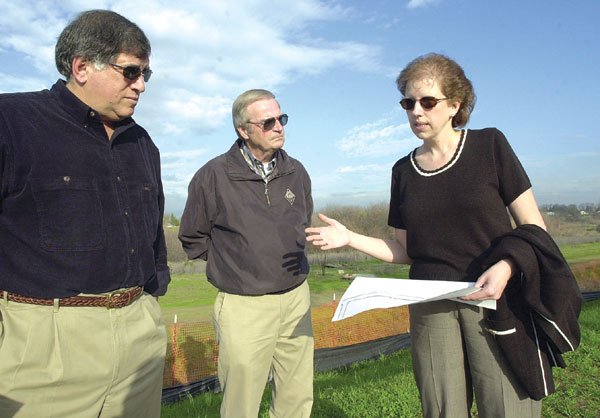GILROY
– As construction of Gilroy’s new middle school nears its final
phase, work to save a more than 100-year-old oak tree at the
once-pristine site is under way.
GILROY – As construction of Gilroy’s new middle school nears its final phase, work to save a more than 100-year-old oak tree at the once-pristine site is under way.
Construction crews are putting the final touches on a cinder-block retaining wall surrounding the 52-inch diameter tree. An arborist for the project believes the wall will protect the tree’s roots, allowing the valley oak to grace the Ascencion Solorsano campus for many years to come.
“It’s important for the kids who will be on this campus to know something else was here before them,” said Gilroy Unified school board President Jim Rogers, who spearheaded the effort to save the tree.
Although he didn’t have to go to the extremes of John Quigley – the Southern California man who chained himself for 10 weeks to a threatened 400-year-old oak tree – Rogers did have to get city planners, project engineers, developers and the school district all on the same page environmentally.
“I was pretty familiar with this area because I take walks here pretty regularly,” Rogers said. “When I realized we’d have a road and a parking lot in this spot, I thought I’d hate to see these trees get wiped out.
Roughly $65,000 later, estimates developer John Filice, the valley oak stands and has a clean bill of health.
“It’s expensive,” said Filice, president of Glen Loma Group, a major residential development player in Gilroy. “I’d say it’s worth it, though. The tree gives an ambiance to the area.”
Filice, whose family had long owned the land, said he used to hunt quail and pheasant in the area.
Ascencion Solorsano Middle School, which sits east of Santa Teresa Boulevard at Club Drive, is set to open at the beginning of next school year. The state-of-the-art campus neighbors more than one Glen Loma housing development, most notably the exclusive Eagle Ridge community.
Because the tree stands within a 100-year flood plain, the road around it had to be elevated by about 6 feet to prevent flooding in times of heavy rain. The immediate spot around the oak was left alone to protect the roots of the tree.
In addition to the oval-shaped retaining wall, a protective fence will be constructed around the area of the tree to ensure pedestrians and vehicles do not inadvertently fall inside the perimeter of the wall.
Not all the trees in the area were as fortunate as the valley oak.
Before construction began, another oak tree in the same area, which was not as healthy as its counterpart, and a nearby sycamore tree wer toppled by a windstorm. Both trees were destroyed.
The effort to save the tree truly went beyond the call of duty, project engineer Armenta Jensen points out. Based on the project’s environmental guidelines, Jensen said, any tree on site could have been destroyed as long as it was replaced with three younger trees.
“But you can’t go out and buy a tree like this out of a box,” Jensen said. “It’s really a testament to teamwork. The school district, the developer, the city – everyone had a hand in this.”
Uprooting, boxing and relocating the tree turned out to be the prescribed course of action in the Quigley case. A similar alternative was discussed for the Solorsano oak, Rogers said.
“But you never know how a tree will do once it’s in a box. They seem to take a long time to recover and start growing again,” Rogers said.














